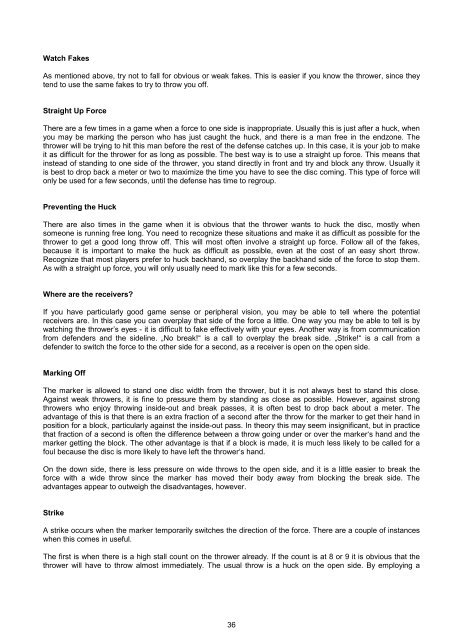You also want an ePaper? Increase the reach of your titles
YUMPU automatically turns print PDFs into web optimized ePapers that Google loves.
Watch Fakes<br />
As mentioned above, try not to fall for obvious or weak fakes. This is easier if you know the thrower, since they<br />
tend to use the same fakes to try to throw you off.<br />
Straight Up Force<br />
There are a few times in a game when a force to one side is inappropriate. Usually this is just after a huck, when<br />
you may be marking the person who has just caught the huck, and there is a man free in the endzone. The<br />
thrower will be trying to hit this man before the rest of the defense catches up. In this case, it is your job to make<br />
it as difficult for the thrower for as long as possible. The best way is to use a straight up force. This means that<br />
instead of standing to one side of the thrower, you stand directly in front and try and block any throw. Usually it<br />
is best to drop back a meter or two to maximize the time you have to see the disc coming. This type of force will<br />
only be used for a few seconds, until the defense has time to regroup.<br />
Preventing the Huck<br />
There are also times in the game when it is obvious that the thrower wants to huck the disc, mostly when<br />
someone is running free long. You need to recognize these situations and make it as difficult as possible for the<br />
thrower to get a good long throw off. This will most often involve a straight up force. Follow all of the fakes,<br />
because it is important to make the huck as difficult as possible, even at the cost of an easy short throw.<br />
Recognize that most players prefer to huck backhand, so overplay the backhand side of the force to stop them.<br />
As with a straight up force, you will only usually need to mark like this for a few seconds.<br />
Where are the receivers?<br />
If you have particularly good game sense or peripheral vision, you may be able to tell where the potential<br />
receivers are. In this case you can overplay that side of the force a little. One way you may be able to tell is by<br />
watching the thrower’s eyes - it is difficult to fake effectively with your eyes. Another way is from communication<br />
from defenders and the sideline. „No break!“ is a call to overplay the break side. „Strike!“ is a call from a<br />
defender to switch the force to the other side for a second, as a receiver is open on the open side.<br />
Marking Off<br />
The marker is allowed to stand one disc width from the thrower, but it is not always best to stand this close.<br />
Against weak throwers, it is fine to pressure them by standing as close as possible. However, against strong<br />
throwers who enjoy throwing inside-out and break passes, it is often best to drop back about a meter. The<br />
advantage of this is that there is an extra fraction of a second after the throw for the marker to get their hand in<br />
position for a block, particularly against the inside-out pass. In theory this may seem insignificant, but in practice<br />
that fraction of a second is often the difference between a throw going under or over the marker‘s hand and the<br />
marker getting the block. The other advantage is that if a block is made, it is much less likely to be called for a<br />
foul because the disc is more likely to have left the thrower‘s hand.<br />
On the down side, there is less pressure on wide throws to the open side, and it is a little easier to break the<br />
force with a wide throw since the marker has moved their body away from blocking the break side. The<br />
advantages appear to outweigh the disadvantages, however.<br />
Strike<br />
A strike occurs when the marker temporarily switches the direction of the force. There are a couple of instances<br />
when this comes in useful.<br />
The first is when there is a high stall count on the thrower already. If the count is at 8 or 9 it is obvious that the<br />
thrower will have to throw almost immediately. The usual throw is a huck on the open side. By employing a<br />
36


